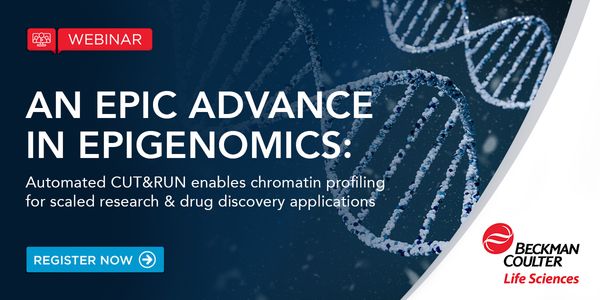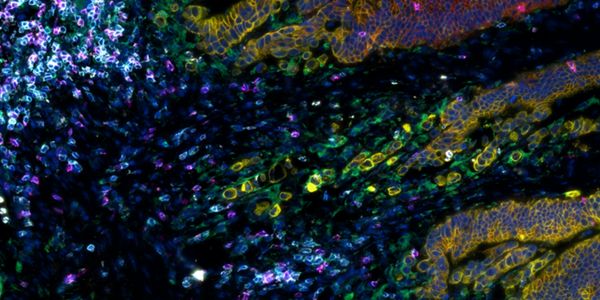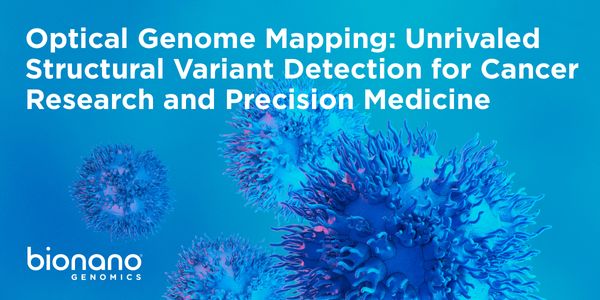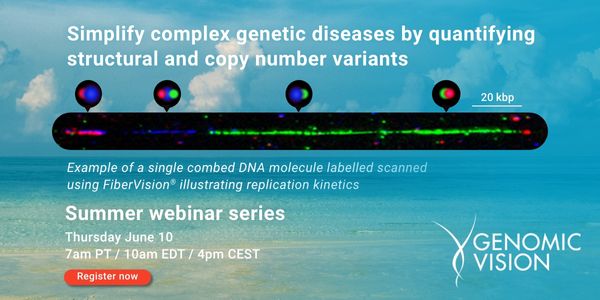Dna mapping
DNA mapping describes methods that describe the position of genes within DNA. Following DNA mapping, one can visualize how far genes are located from one another based on how much detail is displayed on the map.
-
OCT 31, 2023 | 11:00 AMWith the promise of targeted gene editing and CRISPR technologies comes increasing experimental complexity and design challenges. Success in gene editing experiments may depend on many varia...OCT 24, 2023 | 10:00 AMDynamic changes in chromatin drive gene expression programs during cellular development and contribute to pathological changes underlying disease. To date, efforts to characterize chromatin...JAN 25, 2023 | 10:00 AMDate: January 25, 2023 Time: 10:00am (PST), 1:00pm (EST), 7:00pm (CET) The field of proteomics is poised for a single-molecule revolution – enabling more comprehensive analysis of the...DEC 07, 2022 | 9:00 AMDate: December 07, 2022 Time: 9:00am (PST), 12:00pm (EST), 6:00pm (CET) Join us for an exciting live panel webinar, as we celebrate the 60th anniversary of Gibco Cell Culture. The panelists...Speaker: Jessica Hess , Rukia Henry , Ernesto Goulart , Ameet Chimote, PhDSponsored By: Thermo Fisher Scientific/GibcoCancers are genetic diseases driven by recurrent sets of somatic mutations. Different mutations associate statistically with distinct disease risks and can therefore be useful prognostic mar...
OCT 21, 2021 | 7:00 AM
Date: October 21, 2021 Time: 7:00am (PDT), 10:00am (EDT) To simultaneously visualize multiple markers within the same sample enables a more detailed view of cellular phenotypes and how they...
AUG 31, 2021 | 9:00 AM
Date: July 07, 2021 Time: 8:00am (PDT), 11:00am (EDT) The DNA damage response is extremely crucial in maintaining genomic integrity. Failure to repair damaged DNA can result in the propagati...
JUN 30, 2021 | 7:00 AM
Date: June 30, 2021 Time: 7:00am (PDT), 8:00am (EDT) Join us to discover how Optical genome mapping (OGM) mapping can help you in the characterization of complex samples. OGM is a non-sequen...
JUN 10, 2021 | 7:00 AM
Date: June 10, 2021 Time: 7:00am (PDT), 10:00am (EDT), 4:00pm (CEST) Discover how to categorize small-to-large genetic modifications using molecular combing. Our Proprietary Genome Morse Cod...
We are entering into an exciting era of genomics where truly complete, high-quality assemblies of human chromosomes are available end-to-end, or from ‘telomere-to-telomere’ (T2T)...
Combinatorial inhibition of effector and feedback pathways is a promising treatment strategy for KRAS mutant cancers. However, the particular pathways that should be targeted to optimize the...
Viruses are the causative agents of approximately 12% of human cancers. The most recently discovered herpesvirus, Kaposi’s sarcoma herpesvirus (KSHV) is known to cause three human canc...
Prokaryotic DNA contains three types of methylation: N6-methyladenine, N4-methylcytosine and 5-methylcytosine. The lack of tools to analyse the frequency and distribution of methylated resid...
SEP 03, 2020 | 9:00 AM
DATE: September 3, 2020 TIME: 09:00am PT, 12:00pm ET xxx Learning Objectives: xxx Webinars will be available for unlimited on-demand viewing after live event. LabRoots is approved as a provi...
JUN 12, 2020 | 8:00 AM
DATE: June 12, 2020 TIME: 08:00 am PDT, 11:00 am EDT Whole genome imaging using the Saphyr instrument from Bionano detects structural variants (SVs), such as insertions, deletions,...
NCI estimates that cancer will be the leading cause of death in 2030, worldwide. Checkpoint inhibitors and adoptive cell therapies (ACTs) cost up to ~$2 million/patient and have shown durabl...
The basic units of biological structure and function are cells, which exhibit wide variation in regard to both type and state. We assess such variation by simultaneously profiling the transc...
Speaker:
Anindita Basu, PhD
Genomic profiling of liquid biopsies is no longer an emerging area of clinical research, but quickly becoming translated as part of contemporary clinical trials for potential future use in t...























